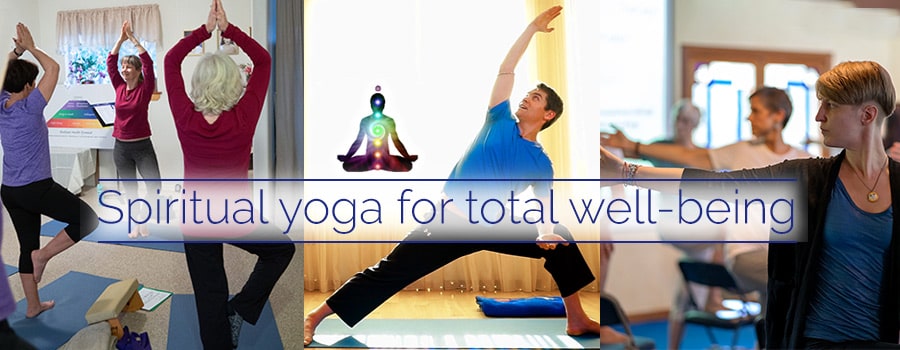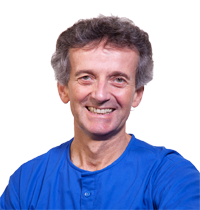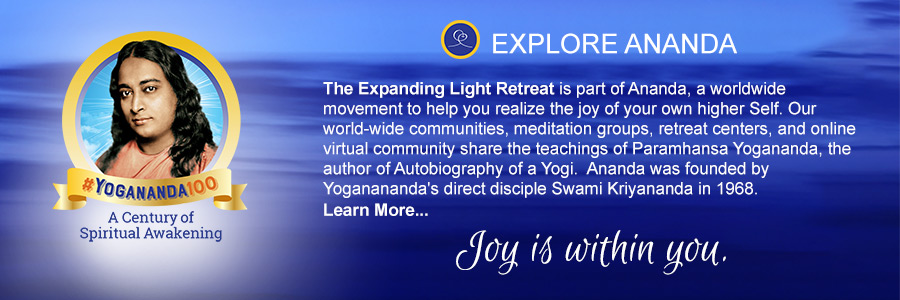|
This article was written for the Ananda Yoga® Teacher Association newsletter. Learn more, or find a certified Ananda Yoga® teacher near you. |
The Art and Science of Happiness
Download a PDF of this article (51 KB)
Yoga has become well known in the West for its many physical and psychological benefits, such as improved muscle tone, lower blood pressure, stress relief, increased vitality, and mental clarity. Yet the original purpose of yoga was — and its highest purpose has always been — spiritual: Yoga is the art and science of attaining true, lasting happiness.
Yoga is a science because it offers specific, practical methods for obtaining these benefits. It is an art, because its highest benefits come only through sensitive and intuitive practice; otherwise it yields only superficial results. To understand these points more fully, let’s take a look at yoga’s lofty goal: true, lasting happiness.
The Highest Aspiration
Yoga maintains that underlying all that exists is a single consciousness that not only created the universe, but became the universe. That is, it formed the universe out of itself, there being no other “building materials” with which to work.
People call that consciousness by many names: Spirit, God, Truth, Love, The Divine, Absolute Existence, etc. Yoga teaches that the essence of that consciousness is joy (ananda in Sanskrit), and since we are part of that consciousness, our own essence, too, must be joy. According to yoga, our innate desire for happiness is the desire to “come home” to our true nature. Whatever people seek in life — love, wealth, fame, power, etc. — they seek it always for the same reason: the happiness they expect to find through it.
The ancient sages of India asked: If lasting happiness is the goal, then why try to find it through things (love, wealth, etc.) that end when human life ends — and usually much sooner than that?! Why not instead seek happiness directly, in the only way that it will last: through uniting our consciousness with the everlasting joy of Spirit? The sages’ explorations gave birth to the many tools and precepts of yoga.
There are numerous yoga traditions, handed down from teacher to student over millennia. 1 Each has its own special emphasis, but all have the same goal: to unite limited human consciousness with the unlimited, ever-joyful divine consciousness. Hence the word, “yoga,” which in Sanskrit means “to yoke” or “to unite.”
The Tools of Yoga
The emphasis of yoga is not on belief, but on direct experience. Yoga says: Believe whatever you want, but try these practices and discover the way to happiness through your own personal experience.
Many people equate yoga with its most visible tools: the asanas (yoga postures), which offer many of the physical benefits of yoga. Depending on how they are practiced, asanas can also give psychological and spiritual benefits. For example, Ananda Yoga (the asana style that I practice and teach) draws upon the power of the mind and heart to amplify the asanas’ natural uplifting effects on consciousness, thereby taking us closer to the joy we seek.
Yet asanas are only a tiny sliver of yoga. Yoga is a complete way of life, giving us practices and insights to enhance everything we do — mundane as well as spiritual, outward as well as inward. Uniting and reinforcing them all is the supreme technique of yoga: meditation.
By quieting our thoughts and feelings, meditation enables us to perceive directly the joy of our true nature. So long as we are active — even in pleasant ways, even just mentally — that deeper joy eludes us. Other yoga techniques convey many benefits, but their greatest value lies in how they support inner stillness. Throughout the ages, yogis have proved that deep, daily meditation is the ultimate tool for experiencing divine joy.
The Energy-Mind Link
There is a highly practical, common thread that unifies all these aspects of yoga: energy.
Since the time of Albert Einstein, science has said — and later proved — that all matter is simply energy. For millennia, yoga has gone a step farther, saying that energy (prana in Sanskrit) not only constitutes our physical bodies, but also intelligently governs the operation of all bodily systems, and is intimately linked to the workings of the mind. To emphasize the “intelligent” aspect of prana, yogis often call it “life force.”
Since the goal of life is a state of mind (i.e., happiness), prana’s connection with the mind is especially relevant. A simple experiment will demonstrate this connection, as well as provide an important insight into why yoga is the science of happiness:
Sit upright with a straight spine, close your eyes, and relax your body. Breathe evenly, and relax your mind as well. Now imagine that, all of a sudden, a friend brings you some stunning good news: “You just won the lottery!” If you imagine this vividly enough, you will feel an inner “lift” that straightens up your body — perhaps even turns your eyes to look upward — and you will inhale. That lift is only partially physical; primarily, it is due to energy rushing upward through your body toward the brain.
Then, just as you’re excitedly planning what you’ll do with your lottery winnings, your friend says, “Sorry, my mistake. You didn’t win after all.” The reverse happens: your body sags, your eyes turn downward, and with an exhalation, you sigh (or curse). Here again, the sagging sensation is only partially physical; it’s mainly due to energy pouring downward through your body.
All this is so familiar that few people bother to take a closer look. Most people simply accept it as an obvious fact of life: Things that we like lift our spirits, and things that we dislike depress us. Thus they continue their “yoyo” existence, reacting positively and negatively, up and down, all day, every day.
The ancient Indian sages, however, did take a closer look. Here’s what they discovered: If our reactions to life’s happy and sad events are always accompanied by upward or downward movements of energy, then by learning to control those inner movements of energy, we can better control our reactions — and thus begin to find the inner joy that doesn’t depend on outer circumstances.
This insight is crucial, because our likes and dislikes (which give rise to our reactions) are far too numerous to correct, one by one. But they all have one thing in common: their link to the inner flow of energy. If this flow can be brought under control, then we can more easily improve our state of mind.
Those sages developed a broad spectrum of yoga practices that help us, each in its own special way, to bring the energy-flow under control. When done correctly, those practices give us the strength and clarity that bring us ever closer to true, lasting happiness.
The Highest Art
That phrase “done correctly” is where the “art” of yoga comes in. For while the mechanics of yoga practice are important, mechanics alone can never govern the subtle realm of human consciousness. Even in the physical realm of asanas, more than mechanics is needed for maximum benefit. The highest success in any aspect of yoga requires that we have the “feel” of the yoga techniques.
In fact, that’s how it is in any field: the highest success requires more than intellect, training, willpower, or motivation. All those are valuable, and no doubt many physicists had as much of them as Einstein, and many artists had as much as Michelangelo. Yet how many could equal those two geniuses? Almost none, because Einstein and Michelangelo had something more: an intuitive understanding of their fields, which took them beyond the limits of the intellect.
How can we gain such an understanding of the art and science of true, lasting happiness? Yoga teaches that the heart is the key — not the physical heart, but rather the heart chakra (energy center) in the middle of the chest. This is where we feel love, and can receive intuitive insight.
But the heart can also be agitated by our likes and dislikes, which keep us in an up-and-down existence. The ancient sage Patanjali put it this way in his Yoga Sutras 2: “Yoga (union) is the neutralization of the whirlpools of likes and dislikes.” When the heart is perfectly calm and receptive, our intuitive (“feeling”) faculty enables us to experience our true essence; when the heart is not calm, our feeling faculty gets caught up in the swirl of emotional reactions, dimming our inner capacity for deep understanding.
Thus it is that many yoga techniques — above all, meditation — involve calming the heart energies. The calmer and more receptive the heart is, the clearer our understanding of anything toward which we turn our attention. Yogis turn their attention toward a deeper understanding of their own essence.
Invaluable Aid
Some rare individuals are able to attain an intuitive understanding of yoga seemingly by themselves, but most need a teacher — someone who has that understanding, and can impart it to the receptive aspirant through means subtler than words or even thoughts. Much progress can be made without a teacher, but to attain that pinnacle of human aspiration — everlasting joy and complete inner freedom — yoga maintains that a teacher is needed.
Thus we come to the much-misunderstood concept of guru. Some spiritual seekers think they do not need a guru. Others fear that a guru will impose upon their free will. To such concerns, Paramhansa Yogananda replied: “People have no idea how to get out of their mental forest. Every path they attempt ends in a confusion of dense undergrowth, or leads them back to where they first started out. In time, the realization dawns on them that they are lost.
“Then, if someone comes and says, ‘I know this forest well; let me show you the way through it,’ will they consider his offer a menace to their free will? Won’t they view it, rather, as an opportunity to accomplish successfully what their own will has been trying for so long, but always in vain, to accomplish?
“The purpose of the guru is not to weaken your will. It is to teach you secrets of developing your inner power, until you can stand unshaken amidst the crash of breaking worlds.” 3
We can gain that ability through the art and science of yoga, aided by the invaluable support of one who has it already. Then we will surely find the true, lasting happiness that we all seek.
About Gyandev (Rich) McCord
Gyandev is the worldwide director of Ananda Yoga, director of Ananda Yoga Teacher Training, and a co-founder of Yoga Alliance. He has been teaching all aspects of yoga since 1983, and has authored numerous books, DVDs and CDs on yoga and yoga therapy. He lives in Northern California in Ananda Village, a yoga community of nearly 300 disciples of Paramhansa Yogananda. Gyandev teaches at Ananda’s spiritual retreat center, The Expanding Light, as well as at various sites across North America, Europe and India.
Gyandev was inspired to teach as he met more and more sincere seekers who wanted a way to go deeper, spiritually. Having himself found Ananda Yoga and meditation to be such a way, he wanted to share those practices to help others experience the deeper dimensions of yoga, and of their own selves. The foundation of his teaching is his practice and study of the teachings of Paramhansa Yogananda, and of Swami Kriyananda, the direct disciple of Yogananda who founded Ananda. His own daily sadhana (spiritual practice) consists of three or more hours of Ananda Yoga, meditation, and Yogananda’s Energization Exercises.
Gyandev finds much encouragement in these words from The Essence of Self-Realization by Paramhansa Yogananda: “Self-realization is the knowing in all parts of body, mind, and soul that you are now in possession of the kingdom of God; that you do not have to pray that it come to you; that God’s omnipresence is your omnipresence; and that all that you need to do is improve your knowing.”
1 I follow the yoga tradition of Paramhansa Yogananda, author of the spiritual classic, Autobiography of a Yogi (Crystal Clarity, Publishers).
2 Patanjali’s Yoga Sutras is one of the two main scriptures of yoga, the other being the Bhagavad Gita. Both date back more than two thousand years.
3 The Essence of Self-Realization, Paramhansa Yogananda, Crystal Clarity, Publishers
Learn More About Ananda Yoga
- Find a certified Ananda Yoga teacher near you
- Read about Ananda Yoga Teacher Training programs
All authors are graduates of Ananda Yoga Teacher Training.





















